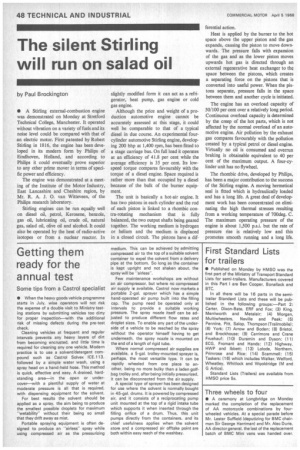Getting them ready for the annual test
Page 50

If you've noticed an error in this article please click here to report it so we can fix it.
Some tips from a Castrol specialist
S When the heavy goods vehicle programme starts in July, wise operators will not risk the expense of a double visit to Ministry testing stations by submitting vehicles too dirty for proper inspection—with the additional risk of missing defects during the pre-test check.
Cleaning vehicles at frequent and regular intervals prevents any heavy layers of dirt from becoming encrusted, and little time is required for cleaning any one vehicle. Modern practice is to use a solvent/detergent compound such as Castrol Solvex ICE.113, followed by a simple water wash, using a spray head on a hand-held hose. This method is quick, effective and easy. A drained, hardstanding area—in the open or undercover—with a plentiful supply of water at moderate pressure is all that is required, with dispensing equipment for the solvent.
For best results the solvent should be applied as a spray, the aim being to produce the smallest possible droplets for maximum .'wetability" without their being so small that they drift away as mist.
Portable spraying equipment is often designed to produce an "airless" spray while using compressed air as the pressurizing medium. This can be achieved by admitting compressed air to the top of a suitable solvent container to expel the solvent from a delivery pipe at the bottom. So long as the container is kept upright and not shaken about, the spray will be "airless".
Few maintenance workshops are without an air compressor, but where no compressed air supply is available, Castrol now markets a portable 2-gal. sprayer which has a simple hand-operated air pump built into the filling cap. The pump need be operated only at intervals to provide a suitable working pressure. The spray nozzle itself can be adjusted to produce different flow rates and droplet sizes. To enable any part of the underside of a vehicle to be reached by the spray without the operator himself having to get underneath, the spray nozzle is mounted on the end of a length of rigid tube.
Where normal compressed air supplies are available, a 5-gal. trolley-mounted sprayer is, perhaps, the most versatile type. It can be rapidly wheeled from one place to another, being no more bulky than a laden golfbag trolley and, after being initially pressurized, it can be disconnected from the air supply.
A special type of sprayer has been designed for use where the solvent is normally bought in 45-gal. drums. It is powered by compressed air, and it consists of a reciprocating pump unit mounted at the top of a rigid intake tube which supports it when inserted through the filling orifice of a drum. Thus, this unit pumps directly from the containers, and its chief usefulness applies when the solvent store and a compressed air offtake point are both within easy reach of the washbay.




























































































































































